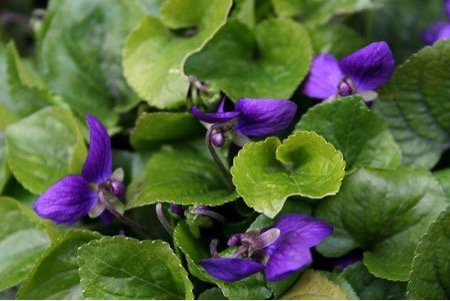
I love native spring ephemerals. They are the first plants to bloom in my garden. After blooming, spring ephemerals disappear until next year. But they are important because they supply the earliest emerging insects with a food supply.
Here are my favorites:
Foamflower (Tiarella cordifolia)
Foamflower is one of the longest-lasting spring ephemerals. It blooms for up to six weeks from early to mid-spring. The heart-shaped foliage lasts longer than other spring ephemerals, so it is an excellent groundcover. Foamflower spreads easily and forms dense colonies. It is is adaptable to a variety of soil and light conditions, and tolerates rabbit and deer browsing.
Virginia Bluebells (Mertensia virginica)
Virginia bluebells bloom for a few weeks early to mid-season. Clusters of pink buds open to lovely blue flowers that attract pollinators. Bluebells will reseed if they are happy in moist well-drained soil and part to full shade. Foliage dies back by summer, so plant bluebells with perennials like ferns. Bluebells are rabbit and deer resistant. I’ve never had deer munch on them.
Mayapple (Podophyllum peltatum)
Mayapple blooms from April through May. The glossy green umbrella-shaped leaves make a unique groundcover. If you peek under the leaves, you will see delicate white flowers. Mayapples like moist, well-drained soils in part to full shade. If given these conditions, they will self-seed. They can tolerate drier soil conditions and short periods of drought.
After flowering, a golden-yellow fruit forms that is food for mammals and the Eastern box turtle. Like all spring ephemerals, Mayapple goes dormant in summer, so plant it with ferns or a late-summer flower or you will have a bare spot in your garden.
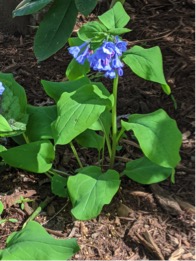
Virginia bluebells (Mertensia virginica) photo credit: Rachel Arnold 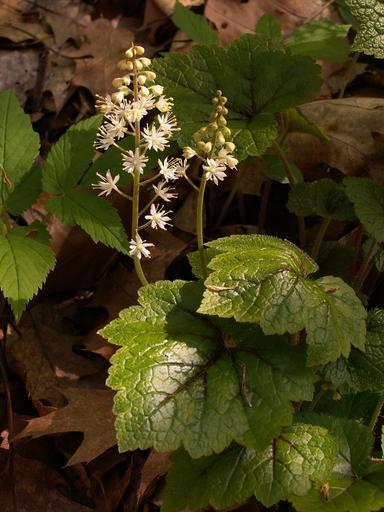
foamflower (Tiarella cordifolia) photo credit: Tom Potterfield 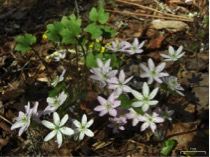
sharp-lobed hepatica (Hepatica nobilis) photo credit Jason Hollinger 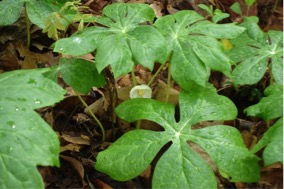
mayapple (Podophyllum peltatum) photo credit: Mandy Smith 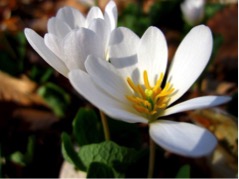
bloodroot (Sanguinaria canadensis) photo credit: Mandy Smith
Bloodroot (Sanguinaria canadensis)
Bloodroot is my all time favorite spring ephemeral. I look forward to seeing them every spring. I first saw these beauties in Ridley Creek State Park. Soon after, they appeared as a volunteer in my garden. They may have been there for some time and I never noticed them because the flowers only last for a few days.
This plant is called bloodroot because its rhizomes (a horizontal underground plant stem that sends out roots and shoots from nodes) ooze an orange-red sap when wounded.
Bloodroot has brilliant white petals and deep yellow heart-shaped pistils and stamens. Lobed blue-green leaves do not appear until after flowering. Bloodroot thrives in average to moist soils and is tolerant of various light conditions.
Sharp-lobed hepatica
Another name for hepatica is liverleaf, since the leaves are liver-shaped. Hepaticas are one of the earliest blooming wildflowers in woodlands across Pennsylvania. They are an important energy source for insects that are out and about in early spring.
These delicate little beauties never fail to please me. The hepaticas in my garden have spread very nicely and are a good groundcover. The leaves persist through summer, but are not evergreen.
Attention bumblebee lovers! Queen bumblebees are out in March searching for the nectar they need to be successful in building a nest and raising babies. The following early spring natives produce what Queens need:
- Jacobs ladder
- Dutchmans breeches
- Violet
- Currents
- Gooseberry
- Willow
- Wild geranium
- Virginia Bluebells
- Redbud
- Blueberry
Every native plant garden needs spring ephemerals. When you add them to your garden, you are helping early-emerging insects find the food sources they need.

Leave a Reply